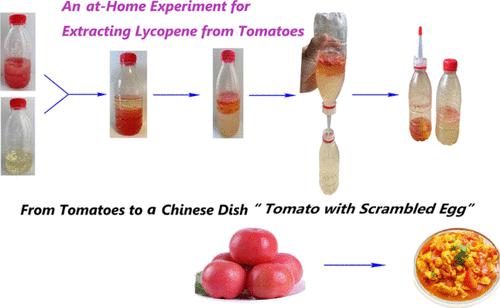当前位置:
X-MOL 学术
›
J. Chem. Educ.
›
论文详情
Our official English website, www.x-mol.net, welcomes your feedback! (Note: you will need to create a separate account there.)
Separation of Lycopene via Liquid–Liquid Extraction: An At-Home Experiment in the Kitchen Laboratory
Journal of Chemical Education ( IF 3 ) Pub Date : 2024-03-19 , DOI: 10.1021/acs.jchemed.3c01190 Shengjie Wang 1 , Zhengsheng Zhan 2
Journal of Chemical Education ( IF 3 ) Pub Date : 2024-03-19 , DOI: 10.1021/acs.jchemed.3c01190 Shengjie Wang 1 , Zhengsheng Zhan 2
Affiliation

|
Herein we describe an accessible and safe at-home experiment to separate lycopene from tomatoes via liquid–liquid extraction. As a qualitative experiment, it is a canonically elementary instance for high school students to digest the conception of miscibility, immiscibility, and density difference of the two solvents. This experiment was performed at a kitchen laboratory, and all the used materials were food-grade and easily available, allowing high school students to physically conduct a foundational lab experiment. Liquid–liquid extraction is an important lab skill, and high school students who perform this at-home lycopene extraction are able to practice experimental skills and probe the underlying theoretical conception, which will aid their future organic chemistry learning in the university.
中文翻译:

通过液液萃取分离番茄红素:厨房实验室的家庭实验
在本文中,我们描述了一种方便且安全的家庭实验,通过液液萃取从西红柿中分离番茄红素。作为定性实验,这是高中生理解两种溶剂的混溶性、不混溶性和密度差概念的典型基础实例。该实验在厨房实验室进行,所有使用的材料都是食品级且易于获得,允许高中生亲自进行基础实验室实验。液液萃取是一项重要的实验室技能,在家中进行番茄红素萃取的高中生能够练习实验技能并探索潜在的理论概念,这将有助于他们未来在大学的有机化学学习。
更新日期:2024-03-19
中文翻译:

通过液液萃取分离番茄红素:厨房实验室的家庭实验
在本文中,我们描述了一种方便且安全的家庭实验,通过液液萃取从西红柿中分离番茄红素。作为定性实验,这是高中生理解两种溶剂的混溶性、不混溶性和密度差概念的典型基础实例。该实验在厨房实验室进行,所有使用的材料都是食品级且易于获得,允许高中生亲自进行基础实验室实验。液液萃取是一项重要的实验室技能,在家中进行番茄红素萃取的高中生能够练习实验技能并探索潜在的理论概念,这将有助于他们未来在大学的有机化学学习。



























 京公网安备 11010802027423号
京公网安备 11010802027423号